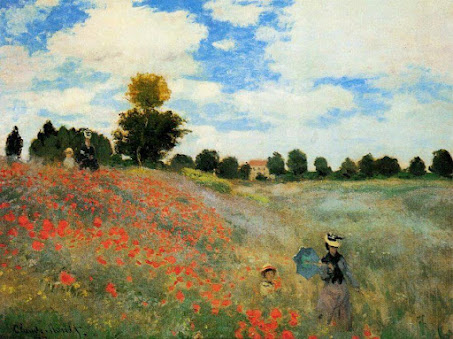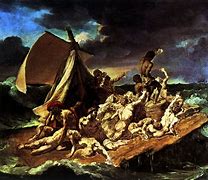Classical Showcase
The Classical Era was mainly characterized by two art styles of the time, being the Rococo and Neoclassical styles. Depicted above is Happy Lovers, a Rococo piece by Jean-Honoré Fragonard painted in London under a commission. This style of art was often put to use in depicting lavish pastimes of the nobility, as well as demonstrating a level of indulgence and comfort. As shown in the above painting, a woman dangles a birdcage above her absolutely transfixed lover, illustrating how captivated he is by her beauty. This kind of painting, with its garden setting, vibrant colors, and curving lines, is unmistakably Rococo. These paintings were often commissioned by aristocrats for display in more intimate areas of homes and properties. The general moral consciousness of the time would find something like this hung in the open for guests to see to be risqué or indecent. Despite this, works such as these flourished and were not only commissioned, but printed and resold to allow their owners to indulge in their visual splendor.
Apart from the moral implications of this piece in its time, it makes wonderful use of multiple artistic methods to relay that sense of pleasure to the viewer. The generous use of curved lines rolls over the eyes, making the piece easy to look at, barring the cage held in the center, perhaps serving as a reminder of the risk involved in chasing love. Vibrant reds on the boy's clothes pop from the natural tones of the background, conveying his passion and inner emotions. This piece is absolutely stunning to me, and I could get lost in every gentle line and bright color it has.
However, in contrast to the Rococo movement, Neoclassical artists focused on a different side of humanity, being their reason and rational place in the world. Shown above is Oedipus and the Sphinx by Jean-Dominique Ingres. He worked on this piece earlier in his life when learning art in Paris and came back to finish it years later. While on the surface this painting could be seen as further indulging in the beauties of the Rococo movement, its setting and tone make a key difference apparent. While addressing the Sphinx, Oedipus lies in a dreary, dark cave, while a man even flees in the background. His reason paints a light upon him, the brightest in the picture, sheltering him from the darkness surrounding him. This portrayal of the story of Oedipus and the Sphinx shows key Neoclassical ideas about humanity and morality. I admire this piece for its dramatic lighting and realistic portrayal of the story.
Neoclassicism emerged from the age of the Enlightenment, a time known for scientific advances and an expansion of human reasoning. Taking inspiration from this time, Neoclassical artists focused primarily on rational, realistic depictions of humanity. This was the second half of the moral view of the arts during the Classical era and is exemplified quite well in this painting through its earlier explained use of tone and space.
“Happy Lovers.” Norton Simon Museum, www.nortonsimon.org/art/detail/F.1965.1.021.P/.
“Oedipus Explains the Enigma of the Sphinx by Jean-Dominique Ingres | Le Site Officiel Du Musée Des Beaux-Arts de Bordeaux.”, www.musba-bordeaux.fr/en/article/oedipus-explains-enigma-sphinx-jean-dominique-ingres.
“François Boucher - Young Woman with a Bouquet of Roses.” Artsdot.com, 2022, en.artsdot.com/@@/8BWLJK-Fran%C3%A7ois-Boucher-Young-Woman-With-A-Bouquet-Of-Roses.






I enjoyed reading your observations between Rococo and Neoclassicism art styles; your description gave some historical information about the Happy Lovers. Hearing a backstory about the artist or what patrons enjoyed buying and displaying their crafted pieces makes the artwork memorable. I could tell Happy Endings was your favorite of the three; I used a painting for the same artist in my blog post. Did you know that Jean-Honoré Fragonard changed to Neoclassicism subjects during the last years of the French Revolution? His style was believed to be too tame because the issues were too close to the pre-Revolutionary. I would have been interested to hear more backstory about why Neoclassicism was developed in your blog post. You brought up the Enlightenment as a big reason for the change. You gave great examples of what caused the changes, but comparing Rococo styles to the Neoclassicism subjects would make a reader know little about art understand better. Thank you for the beautiful showcase of your Classical era blog gallery!
ReplyDeleteI enjoyed reading your observations between Rococo and Neoclassicism art styles; your description gave some historical information about the Happy Lovers. Hearing a backstory about the artist or what patrons enjoyed buying and displaying their crafted pieces makes the artwork memorable. I could tell Happy Endings was your favorite of the three; I used a painting for the same artist in my blog post. Did you know that Jean-Honoré Fragonard changed to Neoclassicism subjects during the last years of the French Revolution? His style was believed to be too tame because the issues were too close to the pre-Revolutionary. I would have been interested to hear more backstory about why Neoclassicism was developed in your blog post. You brought up the Enlightenment as a big reason for the change. You gave great examples of what caused the changes, but comparing Rococo styles to the Neoclassicism subjects would make a reader know little about art understand better. Thank you for the beautiful showcase of your Classical era blog gallery!
ReplyDeleteI apologize to anyone trying to leave a comment and not having it go through, I am currently trying to fix this issue, thank you for reading my blog.
ReplyDelete